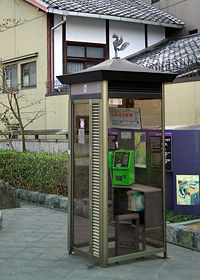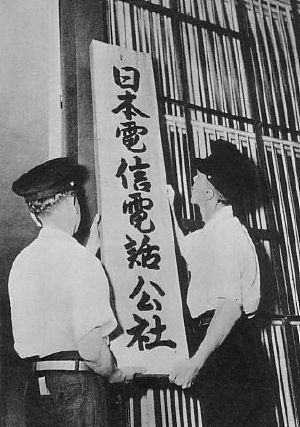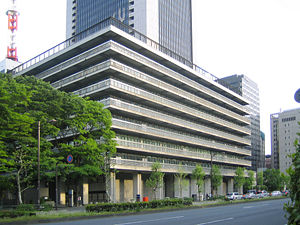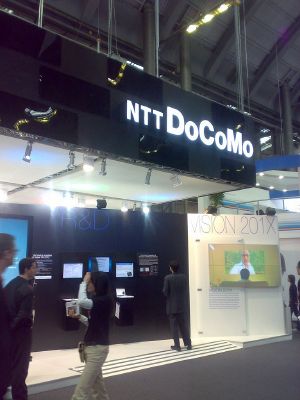Nippon Telegraph And Telephone
 From Nwe
From Nwe | Nippon Telegraph and Telephone Corporation | |

|
|
| Type | Public (TYO: 9432, NYSE: NTT, LSE: NPN) |
|---|---|
| Founded | 1985 (privatized) |
| Headquarters | |
| Key people | Norio Wada, Chairman Satoshi Miura, President & CEO |
| Industry | Telecommunications |
| Revenue | ¥ 10,760.6 billion JPY (2007) |
| Operating income | ¥ 1,107.0 billion JPY (2007) |
| Net income | ¥ 476.9 billion JPY (2007) |
| Employees | 193,800 (2008)[1] |
| Subsidiaries | NTT East, NTT West, NTT Communications, NTT Data, NTT DoCoMo (see #Subsidiaries) |
| Website | www.NTT.co.jp |
Nippon Telegraph and Telephone Corporation (日本電信電話株式会社 Nippon Denshin Denwa Kabushiki-gaisha, TYO: 9432, NYSE: NTT, LSE: NPN), commonly known as NTT, is a telephone company that dominates the telecommunication market in Japan. Ranked the 40th in Fortune Global 500, NTT is the largest telecommunications company in Asia, and the second-largest in the world in terms of revenue. While NTT is listed on Tokyo, New York, and London stock exchanges, the Japanese government still owns roughly one-third of NTT's shares, regulated by the NTT Law. As of March 31, 2008, NTT provided telephone and integrated services digital network services to 46.03 million subscribers; and to 53,388 thousand mobile phone subscribers in Japan.
NTT not only provides telecommunications services but invests in research and development to develop new communications capabilities and devices. In 2001 NTT’s Japanese subsidiary NTT DoCoMo launched the world's first 3G (Third-Generation) telecommunications services, called “Frontier of Mobile multimedia Access” (FOMA); by 2007, FOMA had 40 million subscribers. The NTT Group intends to accelerate the development of the Next-Generation IP network (NGN) that will integrate fixed-line phones with mobile phones, and then promote broadband and ubiquitous services. NTT’s growth strategy involves collaborating with its customers to develop new business models. The NTT Group is also committed to confronting social problems in Japan such as an aging population combined with a dwindling birthrate, environmental conservation issues, disaster-preparedness and the modernization of nursing care and medical care. It is currently testing ICT (Information and Communication Technology) systems that allow health technicians and care providers to monitor the elderly who live alone or in remote locations, and to connect with them and listen to their cares and concerns.
History

Established as a monopoly government-owned corporation in 1953, Nippon Telegraph and Telephone Public Corporation (日本電信電話公社 Nippon Denshin Denwa Kōsha) was privatized in 1985 to encourage competition in the telecom market. In 1987, NTT was listed on stock exchanges in Tokyo, Osaka, Nagoya, Kyoto, Hiroshima, Fukuoka, Niigata, and Sapporo, and its stock was offered in an Initial Public Offering (IPO) at 1.6 million yen. The government sold 1.95 million shares of NTT. In 1988 another 1.5 million government-owned shares of NTT stock were sold. NTT was listed on the New York Stock exchange in September of 1994, and on the London Stock Exchange in October of the same year.[2]
Because NTT owns most of the infrastructure that connect individual consumers to it communications network (last mile), it enjoys oligopolistic control over land lines in Japan. In order to weaken NTT, the company was divided into a holding company (NTT) and three telecom companies (East, West, and Communications) by the NTT Law in 1998. Under this arrangement, NTT East and West provide only short distance communications, and are obligated to maintain telephone service all over Japan. NTT Communications is not regulated by the NTT Law.
Subsidiaries
NTT Group consists of the following major companies, divided into five segments. NTT East, NTT West, NTT Communications, NTT DoCoMo, and NTT Data are most major subsidiaries. NTT DoCoMo and NTT Data are listed on the stock markets.
Regional : NTT East/West
- NTT East
- NTT West
Long Distance & International : NTT Communications
- NTT Communications

NTT Communications Corporation (エヌ・ティ・ティ・コミュニケーションズ株式会社; NTT Communications Kabushiki-gaisha), or “NTT Com,” a wholly-owned subsidiary of Nippon Telegraph and Telephone Corporation, provides network management, security and solution services to consumers, corporations and governments. NTT Com Group has more than 30 companies in the Asia-Pacific region, Europe and the Americas. The company has garnered several awards for its leading edge technologies, outstanding performance and customer service, including "World Communication Awards Best Customer Care - 2005."
NTT Com consists of the following major subsidiary companies:
- AutoWeb Communication Inc
- HKNet
- Verio Inc
- NTT America, Inc.
- NTT Europe Ltd
- Verio Inc
Verio is a web hosting provider in the United States. Incorporated in 1996 in Denver, Colorado, it is currently a wholly owned subsidiary of Nippon Telegraph and Telephone (NTT) Communications, which purchased it in 2000. Verio was formed from a consolidation of over 200 smaller Internet Service Providers (ISPs). Initially, Verio was funded by the principal founders, private investors, NTT, and institutional investors in a private placement. Its goal was to purchase small ISPs around the United States and Europe and achieve economies of scale by rolling them up into one large national ISP. By the year 2000, Verio had purchased almost 50 small ISPs, mostly in the U.S. with a few in Europe.[3] These companies were typically well-known brand names in their local markets, and continued to operate with significant local autonomy after being purchased by Verio. Some of the ISPs purchased by Verio were leading pioneers in the ISP industry, representing the first wave of commercial ISP access in local markets around the US and Europe. [4][5]
During this time Verio had gone public on the NASDAQ, trading under the symbol VRIO. In early 2000 Verio was sold to NTT at a per-share price of over $60, for a total price tag slightly exceeding $5 billion. At that time Japanese law did not allow foreigners to own NTT stock because the Japanese government owned 53 percent of NTT, so the buy-out was structured as a cash sale. The United States Congress held hearings to ensure that the transaction did not violate national security concerns; the Justice Department and the Federal Bureau of Investigation expressed concern that the Japanese government might gain access to classified information if the U.S. government use Verio's network to tap Internet communications during an investigation. NTT agreed to form a separate division within the company staffed only by U.S. citizens to handle any work in support of government investigations, and the sale was allowed to proceed. In the spring of 2000, shortly after deal was announced, the NASDAQ stock market crashed in as the dot-com bubble burst. NTT and Verio completed the transaction by the fall of 2000 at the agreed price of around $60 per share.
Over the next few years Verio abandoned the low-profit consumer internet access market and focused primarily on more lucrative business-to-business web hosting. Much of the original infrastructure it had purchased was disbanded or consolidated into a few large centralized data centers. At the end of 2005, the backbone and some dedicated hosting centers moved to NTT America, while the web hosting business stayed with Verio. At the same time, the European arm, Verio Europe, was moved in its entirety to NTT Europe. In October 2006 Verio Europe was re-named NTT Europe Online. Verio continues to operate as a wholly owned subsidiary of NTT America.
- NTT America
- NTT Europe
NTT Europe, founded in 1989, is a wholly owned subsidiary of NTT Communications, headquartered in London with branch offices in Paris, Düsseldorf, Frankfurt and Amsterdam . NTT Europe provides Managed Network Services, IP Network Services and related services such as IT Service Management and security management for many types of business. It also provides hosting services via its subsidiary NTT Europe Online.
- NTT Europe Online
NTT Europe Online was created in October 2006 when Verio Europewas renamed. It provides managed hosting and related services such as application management and security management for many types of business connected to the Internet. It also provides shared hosting. NTT Europe Online has data centers in London, Paris, Frankfurt, Madrid and Geneva. It acts as an incubation partner for Microsoft’s Software as a Service programme in Europe and is an Oracle On Demand partner.
- HKNet
HKNet is an internet service provider in Hong Kong. Previously one of the major players in the broadband market, HKNet began retreating from the consumer market, and in 2005, transferred its residential customers to the larger Netvigator Broadband ISP owned by PCCW IMS. HKnet still maintains a reputable share in the business market.[6] In 1995 it launched the first Chinese online newspaper, Mingpao.com, and in 1996, the first Internet greeting card center, HKNet iCard Centre.
- Plala Networks
Plala' (NTT ぷらら) is a major Japanese internet service provider, established in 1995 and offering personal internet service. Its major stockholder is NTT Communications Corp[7]. The company's name was changed to "NTT Plala" from "Plala" on March 1, 2008.[8]
Mobile : NTT DoCoMo
- NTT DoCoMo



NTT docomo, Inc.|株式会社エヌ・ティ・ティ・ドコモ|Kabushiki-gaisha Enutiti Dokomo|extra=TYO: 9437, NYSE: DCM, LSE: NDCM}} is the predominant mobile phone operator in Japan. The name is officially an abbreviation of the phrase, "do communications over the mobile network," and is also derived from a Japanese phrase dokodemo, meaning "everywhere." Docomo provides phone, video phone (FOMA and some PHS), i-mode (internet), and mail (i-mode mail, Short Mail, and SMS) services many subscribers in Japan.
Docomo was spun off from Nippon Telegraph and Telephone (NTT) in August 1991 to take over the mobile cellular operations. NTT docomo provides 2G (mova) PDC cellular services in 800 MHz and 1.5 GHz bands (total 34 MHz bandwidth), and 3G FOMA W-CDMA services in the 2 GHz (UMTS2100) and 800 MHz(UMTS800(Band VI)) and 1800 MHz(UMTS1800(Band IX)) bands.
NTT docomo had more than 53 million customers as of March 2008, more than half of Japan's cellular market. The company provides a wide variety of mobile multimedia services including i-mode which provides e-mail and internet access to over 50 million subscribers, and FOMA, launched in 2001 as the world's first 3G mobile service based on W-CDMA. While most mobile operators rely on equipment suppliers for the development and supply of new communication equipment, NTT docomo continues the NTT tradition of very extensive research and development efforts. NTT docomo is the creator of W-CDMA technology as well as mobile i-mode service.
In October 2007, NTT docomo Inc. and Mitsubishi Electric Corp. launched a prototype Wellness mobile phone. It checks the user’s health with a motion sensor that detects body movement and measures calories, and includes a breathalyzer.[9]
In addition to wholly owned subsidiaries in Europe and North America, the company is expanding its global reach through strategic alliances with mobile and multimedia service providers in Asia-Pacific and Europe. NTT docomo is listed on the Tokyo (9437), London (NDCM), and New York (DCM) stock exchanges. In December 2007, NTT docomo and KT Freetel jointly invested US$200 million in a 33 percent stake in U Mobile Malaysia. In November 2008 NTT docomo bought a 26 percent stake in Tata Teleservices, the sixth largest telecom company in India, for US$2.7 billion.
The company's mascot, a mushroom called Docomodake, is quite a celebrity in Japan. He is the hero of a Nintendo DS video game, Docomodake DS, and is present on a wide variety of merchandise such as cell phone straps, key chains, and plush dolls. There are many types of Docomodakes, such as a mother and a father, to symbolize the various plans that NTT docomo offers. The image shown on the right are mainly the normal Docomodakes, with a few musume (daughter) Docomodakes and jiji (grandpa) Docomodakes.
FOMA
FOMA, officially short for Freedom of Mobile multimedia Access, is the brand name of the 3G telecommunications services offered by NTT DoCoMo. NTT DoCoMo originally planned to launch the world's first 3G services, called the Frontier of Mobile multimedia Access (FOMA), in May of 2001.[10] The full-scale launch was postponed until October 2001, and the service was renamed Freedom of Mobile multimedia Access. FOMA successfully launched in October 2001, providing mobile telecommunications coverage to Tokyo and Yokohama. For the first two years, FOMA was essentially an experimental service for early adopters, mainly communication industry professionals. FOMA handsets were big, with a short battery life and the network covered only the center of Japan's largest towns. In 2004 NTT DoCoMo performed a wide-scale upgrade on its network, enabling 100 percent compatibility with UMTS handsets, including incoming and outgoing roaming. [11] In March 2004, sales soared and by September 2007, FOMA had over 40 million subscribers.[12]
Data : NTT Data
- NTT Data
Other Businesses
- NTT Urban Development
- NTT Comware
- NTT Facilities
Vision for the future
NTTs growth strategy, which it calls “Vision 2010,” involves collaborating with its customers to develop new business models. It has declared its intention to become an “ICT Solution Partner” to its business customers, providing support through its expertise in information and communication technology (ICT) to develop their ideas. The "Road to Service Creation Business Group," a new Medium-Term Management Strategy that was announced in May 2008, will work to ensure safe and secure infrastructures for fixed-line and mobile communications services while creating new services in collaboration with application providers. The NTT Group intends to accelerate the development of the Next-Generation IP network (NGN) that will integrate fixed-line phones with mobile phones, and then promote broadband and ubiquitous services. For individual customers, NTT has adopted the slogan, "CreativE-Life" for Everyone, meaning that it strives to create a one-stop Internet service that meet the demands of diverse lifestyles.[13]
Environmental and social responsibility
The NTT Group has pledged to contribute to Japan's economic development, while confronting social problems there such as an aging population combined with a dwindling birthrate, environmental conservation issues, disaster-preparedness and the modernization of nursing care and medical care. The NTT Group is testing ICT-based applications such as sensors that monitor the well-being of elderly people who live on their own and alert family or local authorities of problems; remote health care that uses ICT to connect elderly in their homes with a professional caregiver or rehabilitation center; and a communication service in which volunteers and professional caregivers use ICT to connect with and listen to the cares and concerns of elderly people living on their own. In 2006 the city of Kobe adopted NTT’s monitoring system to augment services for many elderly people left homeless by the Hanshin Awaji Earthquake who are still living alone in temporary housing.[14]
NTT has initiated campaigns to reduce waste and combat global warming, such as reducing its consumption of energy and switching to low-emission vehicles. Each year, the NTT Group issues approximately 119.51 million telephone directories throughout Japan. In 2003 this translated into 103,000 tons of paper, or approximately 0.2 percent of the total amount of paper used in Japan, by 2007 the amount had been reduced to 73,000 tons and 65 percent of this was recycled pulp. NTT regularly evaluates its impact on the environment.
NTT invests in research and development of clean energy and of energy-efficient technology. NTT Energy and Environment Systems Laboratories has been developing ultra low-voltage input booster technology which can play a significant role in boosting the performance of photovoltaic panels, a source of clean energy.[15]
Sponsorship
- Omiya Ardija and Rosso Kumamoto (Japanese football clubs formerly affiliated with NTT)
See also
- Telephone
- Telegraph
- Communication
Notes
- ↑ Company Profile for Nippon Telegraph and Telephone Corp (NTT). Retrieved February 14, 2009.
- ↑ NTT History Retrieved February 14, 2009.
- ↑ The Internet Data Services Report MorganStanley.com. (August 11, 1999), 30. Retrieved February 13, 2009.
- ↑ SEC Info - Verio Inc - 10-K/A - For 12/31/99 Retrieved February 13, 2009.
- ↑ Verio grows big with small clients East Bay Business Times (February 15, 1999)
- ↑ asia.internet.com Realtime News for IT Managers Retrieved February 13, 2009.
- ↑ ぷらら 会社情報 会社概要[1]. (Japanese) accessdate February 14, 2009
- ↑ 社名変更のお知らせ [2]. (Japanese). accessdate February 14, 2009
- ↑ New Prototype Phone Gives Fitness Check.klewtv.com. Retrieved February 14, 2009.
- ↑ Yabusaki, Masami, 2001-03-12, 3GPP TSG_SA Vice-Chairman Nomination. accessdate February 14, 2009
- ↑ NTT Docomo Case Study, Picsel Retrieved February 13, 2009.
- ↑ 3G FOMA Subscribers Exceed 40 Million. accessdate February 14, 2009 October 2, 2007 NTT DoCoMo
- ↑ Satoshi Miura, Message from the President NTT Retrieved February 14, 2009.
- ↑ Initiatives for a Shrinking, Aging Society NTT. Retrieved February 14, 2009.
- ↑ Ecology NTT Retrieved February 13, 2009.
References
ISBN links support NWE through referral fees
- Beck, John C., and Mitchell Wade. 2003. DoCoMo Japan's wireless tsunami: how one mobile telecom created a new market and became a global force. New York: AMACOM. 9780814426791
- Mak, Vincent. 2003. NTT DoCoMo: establishing global 3G standards. [CABC case studies], 00/85C. Hong Kong: Centre for Asian Business Cases, School of Business, University of Hong Kong. 2003.
- Norwitz, Trevor S., Mark L. Reinstra, and Faiza J. Saeed. Counseling clients in the new economy: opportunities for the emerging and established company. New York: Practising Law Institute. 2001. ISBN 9780872249561
- NTT DoCoMo (Firm). A decade of NTT DoCoMo: onward to a new frontier in mobile communications: 1992-2002. [Tokyo]: NTT DoCoMo. 2002.
- Ohboshi, Kouji. The NTT DoCoMo phenomenon: leading the broadband revolution. New York: Wiley, 2002. ISBN 9780470820605.
- Takano, Yoshirō. "Nippon Telegraph and Telephone privatization study: experience of Japan and lessons for developing countries." (World Bank discussion papers, 179.) Washington, DC: World Bank, 1992. ISBN 9780821322246.
Credits
New World Encyclopedia writers and editors rewrote and completed the Wikipedia article in accordance with New World Encyclopedia standards. This article abides by terms of the Creative Commons CC-by-sa 3.0 License (CC-by-sa), which may be used and disseminated with proper attribution. Credit is due under the terms of this license that can reference both the New World Encyclopedia contributors and the selfless volunteer contributors of the Wikimedia Foundation. To cite this article click here for a list of acceptable citing formats.The history of earlier contributions by wikipedians is accessible to researchers here:
- Nippon_Telegraph_and_Telephone history
- NTT_Communications_Corp history
- Verio history
- Nippon_Telegraph_and_Telephone history
- NTT_docomo history
- HKNet history
- NTT_Europe_Ltd history
- Freedom_of_Mobile_Multimedia_Access history
- NTT_Plala history
- NTT_Europe_Online history
The history of this article since it was imported to New World Encyclopedia:
- History of "Nippon Telegraph and Telephone"
Note: Some restrictions may apply to use of individual images which are separately licensed.
↧ Download as ZWI file | Last modified: 02/04/2023 05:07:24 | 31 views
☰ Source: https://www.newworldencyclopedia.org/entry/Nippon_Telegraph_and_Telephone | License: CC BY-SA 3.0
 ZWI signed:
ZWI signed: KSF
KSF